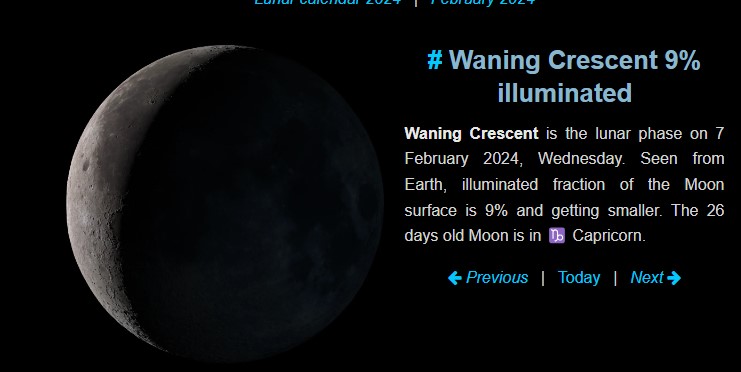Moon phase February 7, 2024: On this day, the moon will be in its Waning Crescent phase. This phase is best seen in the western sky before sunrise. During this phase, the moon’s illumination wanes each day until the new moon. During this part of the lunar cycle, the Moon is close to the Sun as seen from Earth, the lunar night is facing Earth, and only a small edge of the Moon is illuminated.
It is also a good time to view the Moon and its surface features. Along the edge where the light side meets the dark side, craters and mountains cast long shadows, making them easy to see with a telescope or binoculars.
See the February 2024 Moon Phases Calendar for the daily full moon phases for this month.
Moon Phase February 7 2024
Waning Crescent Phase
The waning moon on February 7 has 9% illumination. This is the percentage of the Moon that is illuminated by the Sun. The lighting changes constantly, varying up to 10% from one day to the next. On February 7, the Moon has 26.73 days. This indicates the number of days since the last new year. It takes the Moon 29.53 days to orbit the Earth once and complete its 8-phase lunar cycle.
Moon phase Wednesday February 7, 2024 at 12:00 UTC
Waning Crescent 9% illuminated: The waning new moon is the lunar phase for Wednesday, February 7, 2024. As seen from Earth, 9% of the moon’s surface is illuminated, and it’s getting smaller. The Moon is in Capricorn ♑ for 26 days.
Moon phases for Wednesday, February 7, 2024
On this day, the moon’s age is 26.75 days, its illumination is 10.79%, and its inclination is -293.622 degrees. The distance between the Earth and the Moon is about 369,493.17 kilometers, and the Moon sign is Capricorn.
The moon phase of February 7, 2024 is a waning new moon. During this phase, the moon is less than 50% luminosity, but has not yet reached 0% luminosity (which would be a new moon). During this part of the lunar cycle, as seen from Earth, the Moon approaches the Sun and the dark side of the Moon faces the Earth, illuminated by a thin waning crescent.
The waning (waning) crescent will rise around midnight, cross the meridian just after sunrise, and set just after noon. This phase is best observed an hour or two before sunrise and is also a good time to observe the features of the moon’s surface. Along the illuminated crescent, you can see moon craters and mountains casting long shadows.
Like all moon phases, the waxing gibbous moon will last just over seven days. The actual longitude will vary depending on the elliptical orbit of the Moon. During this waxing gibbous phase, the Moon will rise in the east around mid-afternoon and be high in the eastern sky at dusk.
Assuming a clear night, the waxing gibbous Moon will be visible most of the time before sunset before sunrise.
Fun Fact: The bright side of the waning crescent always points east, toward the rising sun.
Related:


Leave a Reply